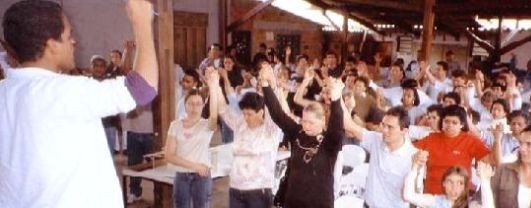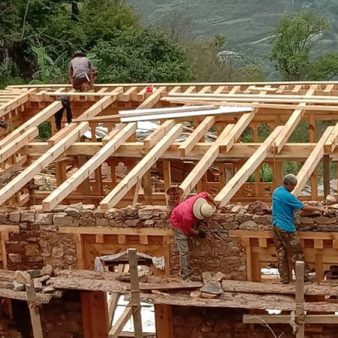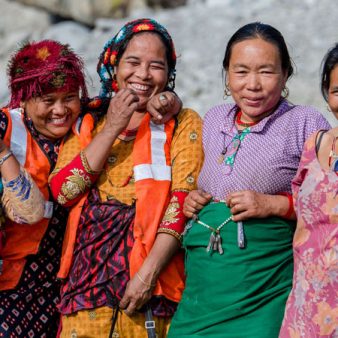Working to support community-led, high-density urban-housing initiatives, this project has worked with nearly 5,000 families from more than 15 urban popular movements across São Paulo. Appropriate technologies have been developed to allow for the construction of complex multi-storey buildings by the residents themselves. Following construction, community facilities and income-generating activities are developed, including community bakeries, childcare facilities and professional training courses.
Project Description
Aims and Objectives
The main objective of USINA is to promote the improvement of living conditions for the lower-income population and provide support in political engagement processes and in the struggle for social justice and the recognition of rights to land, housing and the city. Specific aims include the following:
- To provide technical assistance to urban and rural social movements in architecture, planning and technology, with broad community involvement and interdisciplinary technical teams, aiming at collective production activities.
- To actively support the social movements’ political and social engagement throughout the process, discussing their active participation in the wider social and political context in both urban and rural areas.
- To promote widespread debate and discussion, sharing knowledge through courses, seminars, printed material and research, in partnership with schools, government agencies, social movements, cultural institutions and universities.
Project context
Over the last decades, cities in Brazil have experienced high population growth rates, combined with increasing levels of poverty and unemployment. The chaotic growth is exacerbated by the lack of urban land, with up to 15 per cent of the city’s population living in slums. Houses of up to four storeys are self-built, often in high-risk areas without any form of technical assistance. Large-scale public housing projects developed to address the housing shortage have been carried out by contractors seeking to obtain maximum profit, to the detriment of building quality and largely ignoring the needs of the low-income population.
In this context, people’s organisations in São Paulo began to organise themselves in the struggle for housing, particularly in the 1980s following the collapse of the military regime in Brazil. These movements originated as neighbourhood associations, seeking improvements in specific issues such as access to clean water and electricity. With their growing level of organisation, the movements also grew politically and their struggle began to focus on access to adequate housing and citizenship. The pressure applied by these groups on the public administration resulted in the first self-managed housing programmes for the city’s central region.
Thanks to the people’s movements’ and progressive local authorities, São Paulo has become one of the pioneer cities in the development of participatory housing policies. Since the late 1980s many independent, interdisciplinary technical groups such as USINA have emerged, providing technical assistance to people’s movements and housing cooperatives on these innovative projects.
Key features
USINA supports community-led initiatives and provides technical assistance to low-income families in the construction of high-density housing. Housing is built through a participatory mutual help (‘mutirão’) approach, with self-management of resources.
Whilst USINA has worked with nearly 5,000 families from more than 15 housing groups and movements, the submission highlights three multi-storey housing projects in particular: ‘Copromo’ (160 families, 1990-98), ‘União da Juta’ (160 families, 1992-98) and ‘Paulo Freire’ (100 families, 1998-2007), developed in partnership with organised people’s movements and municipal or state public financing departments.
The project is funded entirely through public resources and residents contribute with their labour (16 hours per week per household). Appropriate technologies have been developed to allow for the construction of complex multi-storey buildings by the residents themselves through a self-managed process. In addition to housing, the project involves the development of community facilities and income-generating activities, including community bakeries, childcare facilities, professional training courses, etc.
These projects differ from many mutual-help housing projects involving unpaid labour in that rather than focusing on reducing costs and public budgets, they establish truly self-managed processes at all stages of the project – from the design phase through to implementation and monitoring – empowering communities and helping to inform public housing policy.
The entire process of design, planning, execution and management of the project is led by the organised community groups. Residents are responsible for allocating funds, sourcing and purchasing materials, organising residents into committees and construction teams and selecting the technical advisory groups with which they would like to work.
Covering costs
USINA’s approach involves mobilising local, state and/or national public resources to support community-led initiatives, ensuring that the state fulfils its responsibilities to the low-income population. A combination of grants, subsidy and loans has been obtained over the years from a range of government sources, including public housing companies (e.g. COHAB-SP and CDHU) and the CAIXA Federal Development Bank. The funds for housing construction through mutual help are transferred directly to the community associations and cover the purchase of materials, safety equipment, on-site facilities and administrative/running costs during construction, as well as the services of technical assistance organisations and specialised labour where needed. Approximately four per cent of the budget is typically allocated to architectural plans and construction documents and an average of six per cent of the overall budget is for the technical and social assistance provided by USINA. Total project costs (excluding land costs – public land for social housing is generally provided on a 100 per cent subsidy basis) average US$12,000 – 15,000 per housing unit.
Impact
- Low-income families are able to access adequate housing and secure land tenure through affordable financial mechanisms.
- Social networks are strengthened through the participatory process.
- The community activities and services established, as well as increased cultural activity and employment opportunities, have benefited the wider community.
- The project provides an example of high-quality multi-storey housing that responds to the needs of low-income families.
- The housing movements have been strengthened and are increasingly recognised as political subjects and producers of the city’s spaces.
Why is it innovative?
- Mutual help construction of multi-storey buildings for densely populated urban areas.
- Participation of homeless groups and social movements in decision-making processes at all stages.
- Use of mixed construction technologies, with steel stair towers and structural blocks, making possible the construction of vertical buildings through mutual help, with unspecialised labour.
- Community management of the process, including the establishment and management of work teams, sub-committees, accident prevention, kitchen and day nursery, etc.
- Collective income-generating initiatives employed upon completion of the construction work.
What is the environmental impact?
The projects, to a large extent, use conventional, locally-available materials such as ceramic block, reinforced concrete slabs, ceramic or fibber-cement roofing tiles and steel or timber door and window frames. Materials are selected by the community, keeping in mind a range of economic, social and environmental concerns. For example, the choice of load-bearing masonry has both social and environmental advantages as it reduces the use of iron and concrete and requires little technical specialisation.
Previous housing conditions were unsanitary and overcrowded with makeshift service connections and limited access to formal urban infrastructure. The projects ensure access to potable water and sanitation, with adequate ventilation and day lighting.
In the case of one rural settlement, where USINA is working with the MST Landless Workers’ Movement to build a sustainable agricultural school, a range of strategies are being employed to ensure environmental sustainability, such as on-site wastewater treatment and the use of dry composting toilets.
Is it financially sustainable?
The project does not rely on external funding from donor agencies; rather, a conscious decision has been made by the people’s organisations and USINA to carry out all activities with public funding from local, state and /or national government agencies and public housing companies. Whilst this has in some cases resulted in delays and long negotiation processes, each community has pulled together and has been able to overcome these difficulties.
The projects have promoted many activities in their community centres and have obtained financing to sustain such activities as libraries, nurseries, music lessons, technical and professional courses, community bakeries and playgrounds.
Employment has been generated in the construction sector and a number of small businesses, including housing cooperatives, have been established as a result of the project.
The funding system for housing construction greatly increases affordability. It is subsidised according to household income, with a 20-25 year repayment period and low interest rates of 2 per cent per year. Land is subsidised and construction costs come to an average of $200/m2. Property titles are granted to individual households, with condominium tenure. If a family were to decide to sell its apartment and relocate, the residents’ association would generally select another family to take its place, reimbursing the outgoing family for the amount paid to date and taking over responsibility for the repayments.
What is the social impact?
Greater community cooperation and integration is a primary focus of the project. The process is community-led and initiated, with residents working together on housing design, planning, development, construction and management. Participatory workshops are carried out and communities receive support from USINA with social as well as technical aspects of the project. The process of mutual help construction in itself provides a valuable tool for achieving community integration and strengthening social networks.
As a result of the various projects carried out by USINA the skills and abilities of participating groups have vastly increased, not only in the construction sector through the mutual help process but also in terms of political engagement and negotiation, personal and commercial financial management and the development of small businesses.
Brazil is characterised by extreme social inequality and government authorities have historically employed public resources to benefit the country’s economic elite. This project is part of a wider struggle by organised civil society to reverse this practice and ensure that public funds are distributed in an equitable manner. As a result, there has been a shift over the years to more progressive policies and administrations that promote the provision of land and housing for vulnerable groups and seek to guarantee the rights of all citizens.
There has been significant participation of women in the project and decision-making processes. Sometimes up to 60-70 per cent of the mutual help groups are comprised of women.
The core aim of USINA’s work is to empower and mobilise low income groups to defend their rights to land, housing and the city and to take a more active role in society. The housing movements in Brazil – and particularly in São Paulo – have seen remarkable achievements, resulting in widespread dissemination and influence on housing policy.
Barriers
- The ‘mutirão’ mutual help project was developed as a result of pressure from the people’s movements, and its acceptance by the public authorities is problematic: the system for the application and release of funds is bureaucratic and subject to government instabilities: the election of a new mayor can halt the projects indefinitely and require fresh negotiations.
- The timing of the self-managed groups and that of the local authorities are generally incompatible – the release of funds is often slow process and governments do not always support the process of families choosing their own suppliers.
- Powerful lobbies in the construction sector – and their links with government – can often stand in the way.
- Over the last years, the organisation of housing movements in São Paulo has also changed, as more and more its leaders are becoming part of progressive administrations in public office, abandoning their role as former activists. Whilst this has been beneficial in many ways, it has also reduced the movements` political ambitions and ability to pressure government.
Faced with the above barriers, USINA as well as the residents have responded with patience and determination, not losing sight of their goals and continuing to struggle and put pressure upon public authorities. Although this has meant that some of the projects suffered long delays and taken years to be completed, the work of the organisation has achieved impressive scale over time, providing many tangible, high-quality examples of successful community-led housing processes.
Lessons Learned
- The experience has brought deep changes to the theory and practice of architecture in Brazil. The idea of participatory design is much more welcome today. One of the greatest lessons the architects have learned is the possibility of using their technical knowledge in organising the population, making up for the housing deficit in a professionally qualified manner.
- The social work developed by technical assistance groups and community associations has undergone transformations over the years. Instead of assessing the needs of individual households, value is placed on people’s organisation in the struggle for land, management of public resources and self-management of the construction process.
- It was through the ‘mutirão’ experience that the social movements` struggle for housing and citizenship has reached such construction budget wide projection; in addition to managing large budgets and making executive decisions on their best use, the movements have also learned how to deal with the public administration and its difficulties.
- The community groups have learned to organise themselves and have shown society they can responsibly manage construction budgets, as well as design and build their homes.
- Women have achieved a different status at home and in society as a whole, showing their potential for work and decision-making in areas they were traditionally allowed to be part of. Men have learned to respect them and treat them equally.
- Local government has learned that housing construction is far from being a merely physical matter with heavy social implications, and that these two aspects cannot be understood or dealt with in isolation from one another. It has learned that flexible financing and programmes are needed to better solve the many demands.
Evaluation
The work of USINA is characterised by a continuous process of reflection, dialogue and evaluation of its activities and approaches. With regards to the specific housing projects, apart from standard needs assessments and internal evaluation processes, formal monitoring and/or post-occupancy surveys have not been carried out on the projects – government agencies neither require nor provide funding for these and the residents’ associations themselves question the need for such formal monitoring activities, asking whether post-occupancy evaluations are carried out in middle-class housing developments.
Transfer
- Over the last 17 years USINA has worked with nearly 5,000 families from a wide range of housing groups and movements. Working in difficult and complex contexts, the organisation has achieved substantial scale in São Paulo, Belo Horizonte and in other rural and urban areas throughout the country.
- The work of USINA has played a key role in the development of a city- and state-wide process of mutual-help housing construction with self-management of resources, involving approximately 25,000 families in the metropolitan area of São Paulo since 1989.
- The approach has been transferred to several other Brazilian states and USINA is currently working with the municipal government of Belo Horizonte on the development of the city’s public housing programme.
- The work of USINA is part of a larger network and body of work that has achieved widespread international recognition and knowledge-sharing, throughout Latin America, in particular.
Partnership
Urban popular movements, local and regional government agencies



